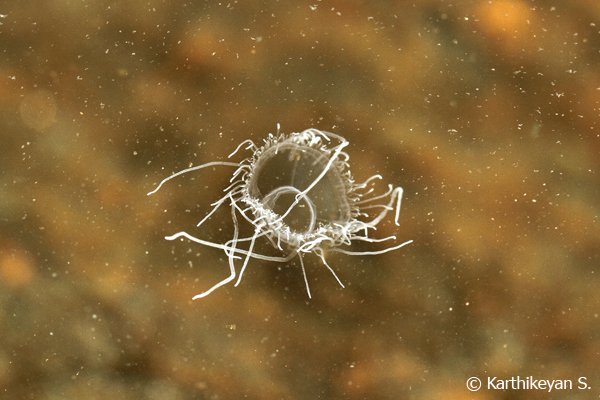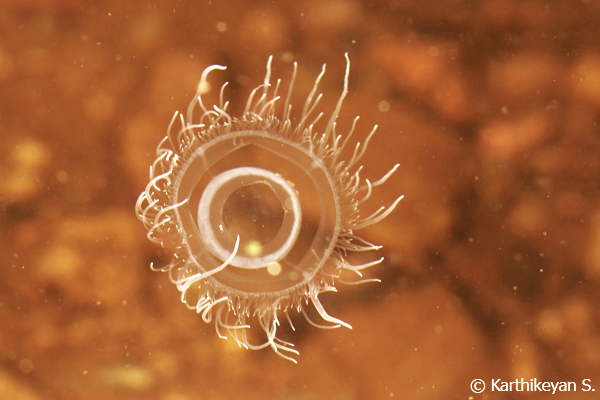It was the winter of 2007. I was visiting River Tern Lodge, located on the backwaters of the Bhadra Reservoir. The view from the cottages is stunning to say the least. A vast expanse of water for as far as the eye can see skirted by the hills of the Western Ghats and the ever-changing shades of the sky above – all come together to create pure magic! Indeed one of the finest locations in Karnataka for a holiday.
After a sumptuous late lunch and a little stroll in the property, I hopped onto the boat for a safari. Having donned the life jacket and armed with my camera, I was ready to soak in whatever Nature would present on the ride. The sun was still shining bright as we cruised along the banks of the reservoir, witnessing and photographing various species of water birds. We had reached as far as was permitted and it was soon time to turn around. The light had gone down a little. As the sun inched closer to a crest on the chain of hills, it painted the sky in a multitude of hues. The evening light striking the forest and the water was magical!
I knew we had adequate time to return to the lodge before the sun went down, throwing a garb of darkness on the landscape. I asked for the boat to be stopped for a moment to enjoy the ambience. The engine killed, the boat drifted very gently on the placid waters. As I looked around, my eyes reached the water just next to the boat. For a second, I thought I noticed something pulsating in the water. I looked again and didn’t see anything as, by now, the boat had moved. I was very certain that I had seen something, so I kept peering into the water.
Suddenly, I noticed that something pulsating again… and it was not alone! To say I was surprised by what I saw would be an understatement. There were hundreds of angelic creatures all around us – gently and lazily floating close to the surface of the water! Each was about an inch across (the size of a one rupee coin) and translucent. The body consisted of a somewhat thick prominent ring attached to an almost transparent sheath that eventually ended in several finger-like projections of varying lengths – comparable to an umbrella with several tassels attached to its rim. It looked like a jellyfish! I quickly took a couple of pictures for the record.

I had until now heard of and seen only jellyfish in the sea. This was a first for me in freshwater! I shared my excitement with the others on the boat. This turned out to be contagious and my fellow companions had a lot of questions for me… what do they eat? are they poisonous? are they dangerous to people? To all their questions, I had to plead ignorance. My colleagues working at the lodge couldn’t help either as they had not seen these jellyfish in the past. This, then, meant that some fact finding was in order.
Now to answer the questions – this jellyfish is found in freshwaters and hence also called as the Freshwater Jellyfish Craspedacusta sp. It has been observed in shallow, slow moving / stagnant water bodies such as wells, ponds and reservoirs. This is exactly the condition in which we witnessed this delicate creature.

The Freshwater Jellyfish is a predator. It is known to feed on microscopic organisms that are found in the water. The prey is caught with their tentacles that are equipped to sting and inject poison that paralyzes the animal. These stings are so small that they are not known to pierce human skin. Therefore, one need not be worried about the freshwater jellyfish stinging human beings. And, as for them present in large numbers as we witnessed – such blooms are nothing unusual and it is thought to be triggered by environmental conditions.
The Freshwater Jellyfish is known to occur in several locations across many countries in the world. In India they have been reported from very few locations – Bhadra reservoir being one of them! They have also turned up in a well and such suitable places in the country. A few years after my first sighting, my colleague happened to spot this in a small rock pool along the Cauvery River.
Nevertheless, what is very interesting is that their occurrence is known to be very unpredictable. So much so that they are known to make sudden appearances in waters where they have not been seen hitherto. Similarly, they are also known to disappear for good or only to be seen several years later. This only goes to show our limited understanding of this beautiful species.
This experience of mine has led me to keep my eyes open every time I am near a water body. I have seen them at Bhadra itself several times during the ensuing years but not at any other location. I shall continue to keep the vigil going in anticipation of another ephemeral sighting. If you keep your eyes peeled around water bodies, you could get lucky too and spot one of these beautiful creatures!